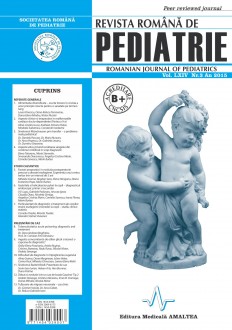SELECT ISSUE

Indexed

| |

|
|
|
| |
|
|
|

|
|
|
|
|
|
|
HIGHLIGHTS
National Awards “Science and Research”
NEW! RJP has announced the annually National Award for "Science and Research" for the best scientific articles published throughout the year in the official journal.
Read the Recommendations for the Conduct, Reporting, Editing, and Publication of Scholarly work in Medical Journals.
The published medical research literature is a global public good. Medical journal editors have a social responsibility to promote global health by publishing, whenever possible, research that furthers health worldwide.
GASTRITIS AND HELICOBACTER PYLORI IN CHILDREN – PRIMARY AND SECONDARY ENDOSCOPIC DIAGNOSIS
Valeriu V. Lupu, Gabriela Paduraru, Ancuta Ignat, Eliza Tighici-Saizu, Claudia Olaru, Nicoleta Gimiga, Angelica Cristina Marin, Cornelia Savescu, Ioana Florea and Marin Burlea
ABSTRACT
The infection with Helicobacter pylori (H pylori) represents an important issue of public health.
Aim. Establishing the prevalence of H. pylori infection in children and presenting the cases according to the gastritis type by performing upper digestive endoscopies.
Material and method. The retrospective study referred to a period of 5 years and included 1269 children evaluated by upper endoscopy to establish the H. pylori infection rate.
Results. The frequency of H. pylori in the case of acute gastritis was significantly more reduced (34.78%) than in the case of chronic gastritis (54.94%). Referring to the 10 types of gastritis, the most frequent ones are purpuric (43.66%), nodular purpuric (25.93%) and nodular antral (15.84%). At the other end, atrophic and hypertrophic gastritis were positioned. The most frequent associations pointed out endoscopically are those with 1st degree esophagitis - 51.6%, duodenitis – 45.07% and purpuric duodenitis – 24.74%.
Conclusions. The H. pylori infection is the most frequent etiologic factor for chronic gastritis (54.94%). The early identification of the infection is essential to destroy the bacteria and to prevent the development of various types of gastritis that are later on endoscopically identified.
Keywords: gastritis, H. pylori, upper endoscopy, child
